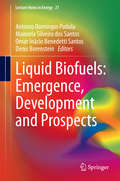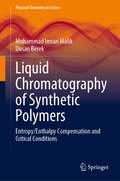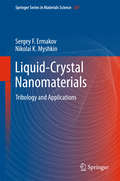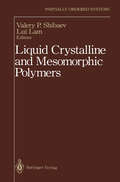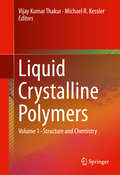- Table View
- List View
Liquid Atomization
by L.P. BayvelCovering the basics of liquid atomization, this book familiarizes readers with the physical processes of liquid atomization, the main types of atomizers and their design, measurements of spray characteristics, experimental investigations of atomizers, and application of atomizers. It demonstrates how to calculate and design atomizers and how to mea
Liquid Atomization
by L.P. BayvelCovering the basics of liquid atomization, this book familiarizes readers with the physical processes of liquid atomization, the main types of atomizers and their design, measurements of spray characteristics, experimental investigations of atomizers, and application of atomizers. It demonstrates how to calculate and design atomizers and how to mea
Liquid Biofuels: Emergence, Development And Prospects (Lecture Notes in Energy #27)
by Sherrill EdwardsBioenergy is coming to be seen as a priority on the international agenda, with the use of liquid biofuels a key strategy in the attempt to meet both the demand for environmental sustainability and the energy needs of countries. The growth in the production and use of biofuels around the world has led to increased interest and discussion about this subject. Given the dynamics of this phenomenon, the organizers of this book, based on more than 10 years experience of joint research on this subject, seek to address key issues relating to the production and marketing of liquid biofuels using the Brazilian experience with ethanol and biodiesel as an illustrative case, as well as the experiences of the leading producers and consumers of biofuels. The topics to be covered in this book include the role of public policies in fostering the emergence of the biofuels industry, the main socio-economic, environmental, technological aspects and the prospects for the sector. The conceptual and methodological bases that provide analytical support to the book are based on recent research published in indexed journals. The structure and content of the book seek to address some central issues regarding: How the biofuel industries have emerged and developed in different countries? What factors have been crucial to the success or failure of different production initiatives? What are the main socio-economic-environmental impacts of the production and consumption of liquid biofuels? How are national and international markets for liquid biofuels being structured? To what extent and/or in what conditions can the experiences and lessons learned at the national level be transferred and adapted in other countries? Finally, based on the scenarios, the prospects for liquid biofuels will be discussed.
Liquid Biofuels: Bioethanol (Biofuel and Biorefinery Technologies #12)
by Carlos Ricardo Soccol Gonçalo Amarante Guimarães Pereira Claude-Gilles Dussap Luciana Porto de Souza VandenbergheThis book covers the present and future of bioethanol biorefinery technologies. It discusses the efficient use of feedstock in bioethanol production, and critically reviews the environmental sustainability of bioethanol production. In addition, it describes the integrated production of bioelectricity, biopolymers, organic acids, and other biomolecules, as well as the use of process-related liquid and solid byproducts and/or wastes during bioethanol generation.Since the bioethanol industry has also led the automotive industry to explore new avenues, this book summarizes the various aspects of ethanol motorization, hybrid engine development, and biofuel electrification. For decades, clean and renewable alternatives have been sought to reduce dependence on petroleum-based fossil fuels and CO2 emissions. Bioethanol appears as one of the best solutions for the production of biofuels, bioenergy and biochemicals, along with the establishment of new biorefinery concepts and a circular bioeconomy. Therefore, the ideas and technologies presented in this book contribute to the UN Sustainable Development Goal 7: Affordable and Clean Energy.This book is a useful reference for postgraduate students and researchers interested in biorefinery and biofuel technologies, both in academia- and commercial laboratories. Early career scientists can use it to fast track into the field. Advanced scientists will find it helpful to gain a broader overview of the field beyond their area of specialization.
Liquid Chromatography of Synthetic Polymers: Entropy/Enthalpy Compensation and Critical Conditions (Physical Chemistry in Action)
by Muhammad Imran Malik Dusan BerekThis book elucidates the peculiar phenomenon of entropy/enthalpy compensation that takes place in high performance liquid chromatography (HPLC) of polymers. Numerous publications, including some books, are devoted to molecular characterization of synthetic polymers, materials presently produced in large and steadily growing quantities, applying methods of HPLC. A knowledge of the molecular characteristics of polymers is indispensable, not only for their proper applications but also for their recycling and remediation. Polymer scientists generally focus on synthesis and potential applications of polymers while not giving due attention to an important central link, their comprehensive characterization in context of development of structure-property correlations. To fill this gap is one of the aims of the present book. The process of entropy/enthalpy compensation plays a decisive role in the advanced method of polymer characterization such as liquid chromatography at critical conditions, eluent gradient interaction chromatography, and temperature gradient interaction chromatography. All chemists working on any aspect of polymer science will find this book a valuable resource for the development of structure-property correlations.
Liquid Crystal Colloids (Soft and Biological Matter)
by Igor MuševičThis book brings together the many concepts and discoveries in liquid crystal colloids contributed over the last twenty years and scattered across numerous articles and book chapters. It provides both a historical overview of the development of the field and a clear perspective on the future applications in photonics. The book covers all phenomena observed in liquid crystal colloids with an emphasis on experimental tools and applications of topology in condensed matter, as well as practical micro-photonics applications. It includes a number of spectacular manifestations of new topological phenomena not found or difficult to observe in other systems. Starting from the early works on nematic colloids, it explains the basics of topological defects in ordered media, charge and winding, and the elastic forces between colloidal particles in nematics. Following a detailed description of experimental methods, such as optical tweezing and particle tracking, the book eases the reader into the theoretical part, which deals with elastic deformation of nematic liquid crystals due to inclusions and surface alignment. This is discussed in the context of basic mean field Landau-de Gennes Q-tensor theory, with a brief explanation of the free-energy minimization numerical methods. There then follows an excursion into the topology of complex nematic colloidal structures, colloidal entanglement, knotting and linking. Nematic droplets, shells, handlebodies and chiral topological structures are addressed in separate chapters. The book concludes with an extensive chapter on the photonic properties of nematic dispersions, presenting the concept of integrated soft matter photonics and discussing the concepts of nematic and chiral nematic microlasers, surface-sensitive photonic devices and smectic microfibers. The text is complemented by a large bibliography, explanatory sketches and beautiful micrographs.
Liquid Crystal Display Drivers: Techniques and Circuits
by David J.R. Cristaldi Salvatore Pennisi Francesco PulvirentiLiquid Crystal Display Drivers deals with Liquid Crystal Displays from the electronic engineering point of view and is the first expressively focused on their driving circuits. After introducing the physical-chemical properties of the LC substances, their evolution and application to LCDs, the book converges to the examination and in-depth explanation of those reliable techniques, architectures, and design solutions amenable to efficiently design drivers for passive-matrix and active-matrix LCDs, both for small size and large size panels. Practical approaches regularly adopted for mass production but also emerging ones are discussed. The topics treated have in many cases general validity and found application also in alternative display technologies (OLEDs, Electrophoretic Displays, etc.).
The Liquid Crystal Display Story: 50 Years of Liquid Crystal R&D that lead The Way to the Future
by Naoyuki KoideThis book focuses on the development of liquid crystal displays (LCDs) and liquid crystal materials (LCs) in Japan. The Committee of Organic Materials Research for Information Sciences of the Japan Society for the Promotion of Science (JSPS) planned the book to document essential LCD innovations and developments since the beginnings of the field-effect LCD technology in 1970. The book illustrates the remarkable effort and progress behind those flat, lightweight, and high-information-content LCDs that have become the indispensable human–machine interface for virtually all electronic devices. In contrast to other publications on this topic, the book illustrates the interdisciplinary character of the LCD technology and its crucial importance for technological progress of the field far beyond displays. It also gives insights into breakthrough innovations not revealed in other publications. Moreover, prospects for the development of LC research toward new fields of applications are provided. In line with its interdisciplinary character, the book targets researchers in basic science as well as engineers and researchers in industry.
Liquid Crystal Displays: Fundamental Physics and Technology (Wiley Series in Display Technology #29)
by Robert H. ChenAn unprecedented look into the basic physics, chemistry, and technology behind the LCD Most notably used for computer screens, televisions, and mobile phones, LCDs (liquid crystal displays) are a pervasive and increasingly indispensable part of our lives. Providing both an historical and a business-minded context, this extensive resource describes the unique scientific and engineering techniques used to create these beautiful, clever, and eminently useful devices. In this book, the history of the science and technology behind the LCD is described in a prelude to the development of the device, presenting a rational development theme and pinpointing innovations. The book begins with Maxwell's theory of electromagnetism, and the ultimately profound realization that light is an electromagnetic wave and an electromagnetic wave is light. The power of mathematical physics thus was brought to bear upon the study of light, and particularly the polarization of light by material bodies, including liquid crystals. After a brief historical description of polarization, a physical interpretation provides substance to the mathematical concepts. Subsequent chapters cover: Thermodynamics for liquid crystals The Maier-Saupe mean field, phenomenological, static continuum, and dynamic continuum theories The transistor and integrated circuit Glass, panels, and modules The calculus of variations The active matrix Semiconductor fabrication The global LCD business Additionally, the book illustrates how mathematics, physics, and chemistry are put to practical use in the LCDs we use every day. By describing the science from an historical perspective and in practical terms in the context of a device very familiar to readers, the book presents an engaging and unique view of the technology for everyone from science students to engineers, product designers, and indeed anyone curious about LCDs. Series Editor: Anthony C. Lowe, The Lambent Consultancy, Braishfield, UK The Society for Information Display (SID) is an international society, which has the aim of encouraging the development of all aspects of the field of information display. Complementary to the aims of the society, the Wiley-SID series is intended to explain the latest developments in information display technology at a professional level. The broad scope of the series addresses all facets of information displays from technical aspects through systems and prototypes to standards and ergonomics.
Liquid Crystal Displays: Fundamental Physics and Technology (Wiley Series in Display Technology)
by Robert H. ChenAn unprecedented look into the basic physics, chemistry, and technology behind the LCD Most notably used for computer screens, televisions, and mobile phones, LCDs (liquid crystal displays) are a pervasive and increasingly indispensable part of our lives. Providing both an historical and a business-minded context, this extensive resource describes the unique scientific and engineering techniques used to create these beautiful, clever, and eminently useful devices. In this book, the history of the science and technology behind the LCD is described in a prelude to the development of the device, presenting a rational development theme and pinpointing innovations. The book begins with Maxwell's theory of electromagnetism, and the ultimately profound realization that light is an electromagnetic wave and an electromagnetic wave is light. The power of mathematical physics thus was brought to bear upon the study of light, and particularly the polarization of light by material bodies, including liquid crystals. After a brief historical description of polarization, a physical interpretation provides substance to the mathematical concepts. Subsequent chapters cover: Thermodynamics for liquid crystals The Maier-Saupe mean field, phenomenological, static continuum, and dynamic continuum theories The transistor and integrated circuit Glass, panels, and modules The calculus of variations The active matrix Semiconductor fabrication The global LCD business Additionally, the book illustrates how mathematics, physics, and chemistry are put to practical use in the LCDs we use every day. By describing the science from an historical perspective and in practical terms in the context of a device very familiar to readers, the book presents an engaging and unique view of the technology for everyone from science students to engineers, product designers, and indeed anyone curious about LCDs. Series Editor: Anthony C. Lowe, The Lambent Consultancy, Braishfield, UK The Society for Information Display (SID) is an international society, which has the aim of encouraging the development of all aspects of the field of information display. Complementary to the aims of the society, the Wiley-SID series is intended to explain the latest developments in information display technology at a professional level. The broad scope of the series addresses all facets of information displays from technical aspects through systems and prototypes to standards and ergonomics.
Liquid Crystal Displays: Addressing Schemes and Electro-Optical Effects (Wiley Series in Display Technology)
by Ernst LuederIn this second edition of Liquid Crystal Displays, Ernst Lueder provides a timely update to his successful text. His unique combination of theory and practice presents all the information required for the development and manufacture of modern high performance and energy saving LCDs. The author also strives for an easy to understand description of complex facts. The second edition focuses on a variety of liquid crystal cells and their electronic addressing, and outlines new developments including: High performance VA cells, especially for TV, due to two subpixels with excellent γ-correction also at oblique viewing Short optical response times in the range of 1 ms also for inter-gray transitions due to novel addressing waveforms Fringe field switching for acceleration of rise and decay of luminance eliminating frame memories Reduction of motion blur by scanning backlights, high frequency frames, edge enhancement and motion blur modeling Very thin LCDs with power saving LED backlights exhibiting unmatched color purity and larger than NTSC color gamut Printed layers on hydrophobic and hydrophilic areas replacing photolithography Practicing electrical engineers, physicists, chemists and display specialists will find this a valuable resource. Researchers will appreciate the practical guidance given for the design of improved LCDs, whilst students are provided with a useful overview of the field. The Society for Information Display (SID) is an international society, which has the aim of encouraging the development of all aspects of the field of information display. Complementary to the aims of the society, the Wiley-SID series is intended to explain the latest developments in information display technology at a professional level. The broad scope of the series addresses all facets of information displays from technical aspects through systems and prototypes to standards and ergonomics
Liquid Crystal Displays: Addressing Schemes and Electro-Optical Effects (Wiley Series in Display Technology)
by Ernst Lueder Seung Hee Lee Peter KnollLIQUID CRYSTAL DISPLAYS THE NEW EDITION OF THE GOLD-STANDARD IN TEACHING AND REFERENCING THE FUNDAMENTALS OF LCD TECHNOLOGIES This book presents an up-to-date view of modern LCD technology. Offering balanced coverage of all major aspects of the field, this comprehensive volume provides the theoretical and practical information required for the development and manufacture of high-performance, energy-efficient LCDs. The third edition incorporates new technologies and applications throughout. Several brand-new chapters discuss topics such as the application of Oxide TFTs and high mobility circuits, high-mobility TFT-semiconductors in LCD addressing, liquid crystal displays in automotive instrument clusters and touch-screen systems, and the use of ultra-high-resolution LCD panels in augmented reality (AR) and virtual reality (VR) displays. This practical reference and guide: Provides a complete account of commercially relevant LCD technologies, including their physics, mathematical descriptions, and electronic addressing Features extensively revised and expanded information, including more than 150 pages of new material Includes the addition of Oxide Transistors and their increased mobilities, the advances of fringe field switching and an overview of automotive displays Presents quantitative results with full equation sets, their derivation, and tabular summaries of related information sets
Liquid Crystal Displays: Addressing Schemes and Electro-Optical Effects (Wiley Series in Display Technology)
by Ernst Lueder Seung Hee Lee Peter KnollLIQUID CRYSTAL DISPLAYS THE NEW EDITION OF THE GOLD-STANDARD IN TEACHING AND REFERENCING THE FUNDAMENTALS OF LCD TECHNOLOGIES This book presents an up-to-date view of modern LCD technology. Offering balanced coverage of all major aspects of the field, this comprehensive volume provides the theoretical and practical information required for the development and manufacture of high-performance, energy-efficient LCDs. The third edition incorporates new technologies and applications throughout. Several brand-new chapters discuss topics such as the application of Oxide TFTs and high mobility circuits, high-mobility TFT-semiconductors in LCD addressing, liquid crystal displays in automotive instrument clusters and touch-screen systems, and the use of ultra-high-resolution LCD panels in augmented reality (AR) and virtual reality (VR) displays. This practical reference and guide: Provides a complete account of commercially relevant LCD technologies, including their physics, mathematical descriptions, and electronic addressing Features extensively revised and expanded information, including more than 150 pages of new material Includes the addition of Oxide Transistors and their increased mobilities, the advances of fringe field switching and an overview of automotive displays Presents quantitative results with full equation sets, their derivation, and tabular summaries of related information sets
Liquid Crystal Elastomers: Materials and Applications (Advances in Polymer Science #250)
by Wim H. JeuPreparation of Liquid Crystalline Elastomers, by F. Brömmel, D. Kramer, H. Finkelmann Applications of Liquid Crystalline Elastomers, by C. Ohm, M. Brehmer und R. Zentel Liquid Crystal Elastomers and Light, by Peter Palffy-Muhoray Electro-Opto-Mechanical Effects in Swollen Nematic Elastomers, by Kenji Urayama The Isotropic-to-Nematic Conversion in Liquid Crystalline Elastomers, by Andrija Lebar, George Cordoyiannis, Zdravko Kutnjak und Bostjan Zalar Order and Disorder in Liquid-Crystalline Elastomers, by Wim H. de Jeu und Boris I. Ostrovskii
Liquid Crystal Flat Panel Displays: Manufacturing science and technology
by William C. O'MaraWe live in the silicon age, and the quintessential item that defines our world is the computer. Silicon chips power the computer as well as many other products for work and leisure, such as calculators, radios, and televisions. In the forty years since the transistor was invented, the solid state revolution has affected the lives of almost everyone in the world. Based on silicon, solid state devices and integrated circuits have revolutionized electronics, data processing, communica tions, and the like. The computer, especially the personal computer, would be impossible without silicon devices. Only one computer was ever built using vacuum tubes, and the tubes had to be constantly replaced because they generated too much heat and burned out. Silicon devices allowed for reliable switching operations in arrays of hundreds and thousands of discrete devices. As a result, the very substantial industrial base that existed for producing vacuum tubes disappeared -with one exception. That exception is, of course, the CRT, which is evident in televisions, computer displays, and a host of other information display terminals. Until recently, there was nothing that could take its place, and it seemed that the CRT would remain as the electronic medium for all except the simplest displays. The CRT is about to go the way of the other vacuum tubes. It's dead, but doesn't know it yet.
Liquid-Crystal Nanomaterials: Tribology and Applications (Springer Series in Materials Science #267)
by Sergey F. Ermakov Nikolai K. MyshkinThis book discusses the tribological, rheological and optical properties of liquid-crystal nanomaterials as well as lubricant media. It also describes the formation of liquid-crystal materials and the application of cholesteric liquid-crystal compounds in technical friction units and in human and animal joints. Further, it shows the connection between the tribological and other physical properties of liquid-crystal cholesterol compounds and develops a lubricity conceptual model of cholesteric–nematic, liquid-crystalline nanostructures on the basis of physical and energetic interpretations. This general model is valid for all surfaces and friction pairs, including biopolymers, and could lead to applications of cholesteric liquid-crystalline nanomaterials in different friction units and tribosystems as well as in the treatment of joint diseases.
Liquid-Crystal Polymers (Specialty Polymers)
Drawing a picture of the current situation of this new field, this volume both summarizes the past achievements and analyzes the present unsolved problems.
Liquid Crystal Polymers: From Structures to Applications (Polymer Liquid Crystals Series #1)
by A. A. CollyerThe subject of liquid crystals and their use in electronic displays and in non-linear optical systems has become of tremendous importance during the last decade; and the incorporation of liquid crystal units into polymeric materials has led to a group of new materials with diverse properties. Some of these properties have been utilized in new products and some have yet to be used. Much published work has appeared that deals with specific materials or particular applications, and it was felt that a book was needed to examine and explain the underlying principles governing the diverse properties of these liquid crystal polymers, LCPs. The current work describes the diverse nature of LCPs, their synthesis, characterization, properties and finally their applications. It describes the manner in which liquid crystallinity or mesomorphism occurs in small molecules, monomer liquid crystals and polymer liquid crystals. Chapter 1 gives a classification of the various ways in which the meso gens may be connected to the polymer chains. Currently, the bulk of LCP material is based on main chain or longitudinal LCPs for use in engineering applications. The side chain or comb polymers are intended for use in electronics and opto-electronic systems and as surfactants. Many other variants and possibilities exist but their properties have not yet been fully studied or used. In this respect it is hoped that the current work will indicate future possibilities as well as discussing current opinion. v Preface vi Chapters 2 and 3 describe methods of characterizing the mesophases.
Liquid Crystalline and Mesomorphic Polymers (Partially Ordered Systems)
by Valery P. Shibaev Lui LamAmong the various new directions in modern polymer science, the design and investigation of liquid crystal (LC) polymers have been the ones growing most actively and fruitfully. In spite of that, the possible formation of an anisotropic LC phase was only demonstrated theoretically for the first time in the 1950s by Onsager [1] and Flory [2], and then experimentally verified in the studies with polypeptides solutions. In essence, the studies of these LC lyotropic systems did not deviate from the theme of purely academic interest. It was at the beginning of the 1970s that the experimental "explosion" occurred, when aromatic polyamides were synthesized and their ability to form LC solutions in certain very aggressive solvents was discovered. The search for practical applications of such LC systems was crowned with the successful creation of the new generation of ultrastrong high-modulus ther mostable fibers, such as the Kevlar, due to the high degree of order of the macromolecules in the anisotropic LC state. In fact, these investigations coincided with the swift emergence on the practical "scene" of thermotropic low-molar-mass liquid crystals, with the use of these materials in microelectronics and electro optics (figures and let ters indicators, displays in personal computers, and flat TV, etc.). Polymer scientists also began to develop methods of synthesizing thermotropic LC polymers by incorporating mesogenic fragments in the main (main-chain LC polymers) or side branchings of the macromolecules (side-chain or comb shaped polymers).
Liquid Crystalline Functional Assemblies and Their Supramolecular Structures (Structure and Bonding #128)
by Takashi KatoThis book presents critical reviews of the present position and future trends in modern chemical research concerned with chemical structure and bonding. It contains short and concise reports, each written by the world's renowned experts. Still valid and useful after 5 or 10 years, more information as well as the electronic version of the whole content is available at: springerlink.com.
Liquid Crystalline Polymers: Volume 2--Processing and Applications
by Vijay Kumar Thakur Michael R. KesslerThis book introduces various applications of liquid crystalline polymers as the emerging new class of high performance novel materials. The authors detail the advantageous properties of these LCs including optical anisotropic, transparency and easy control over structure. This interdisciplinary work includes valuable input from international projects with special focus on the use of liquid crystalline polymers and/or nanocomposites.
Liquid Crystalline Polymers: Volume 1–Structure and Chemistry
by Vijay Kumar Thakur Michael R. KesslerThis book introduces anisotropic innovations in liquid crystalline polymers as well as new nanocomposite materials and testing techniques. The authors detail the newest discoveries of material properties, material types and phases, and material characterization. This interdisciplinary work creates valuable links that strengthen the approach to the evolving field of liquid crystalline polymers/ materials.
Liquid Crystalline Semiconductors: Materials, properties and applications (Springer Series in Materials Science #169)
by Richard J. Bushby, Stephen M. Kelly and Mary O’NeillThis is an exciting stage in the development of organic electronics. It is no longer an area of purely academic interest as increasingly real applications are being developed, some of which are beginning to come on-stream. Areas that have already been commercially developed or which are under intensive development include organic light emitting diodes (for flat panel displays and solid state lighting), organic photovoltaic cells, organic thin film transistors (for smart tags and flat panel displays) and sensors.Within the family of organic electronic materials, liquid crystals are relative newcomers. The first electronically conducting liquid crystals were reported in 1988 but already a substantial literature has developed. The advantage of liquid crystalline semiconductors is that they have the easy processability of amorphous and polymeric semiconductors but they usually have higher charge carrier mobilities. Their mobilities do not reach the levels seen in crystalline organics but they circumvent all of the difficult issues of controlling crystal growth and morphology. Liquid crystals self-organise, they can be aligned by fields and surface forces and, because of their fluid nature, defects in liquid crystal structures readily self-heal.With these matters in mind this is an opportune moment to bring together a volume on the subject of ‘Liquid Crystalline Semiconductors’. The field is already too large to cover in a comprehensive manner so the aim has been to bring together contributions from leading researchers which cover the main areas of the chemistry (synthesis and structure/function relationships), physics (charge transport mechanisms and optical properties) and potential applications in photovoltaics, organic light emitting diodes (OLEDs) and organic field-effect transistors (OFETs).This book will provide a useful introduction to the field for those in both industry and academia and it is hoped that it will help to stimulate future developments.
Liquid Crystals (Wiley Series in Pure and Applied Optics #64)
by Iam-Choon KhooThe fundamental science and latest applications of liquid crystal technologies An excellent professional reference and superior upper-level student text, Liquid Crystals, Second Edition is a comprehensive treatment of all the basic principles underlying the unique physical and optical properties of liquid crystals. Written by an internationally known pioneer in the nonlinear optics of liquid crystals, the book also provides a unique, in-depth discussion of the mechanisms and theoretical principles behind all major nonlinear optical phenomena occurring in liquid crystals. Fully revised and updated with the latest developments, this Second Edition covers: Basic physics and optical properties of liquid crystals Nematics, as well as other mesophases such as smectics, ferroelectrics, and cholesterics Fundamentals of liquid crystals for electro-optics, and display and non-display related applications Various theoretical and computational techniques used in describing optical propagation through liquid crystals and anisotropic materials Nonlinear optics of liquid crystals, including updated literature reviews and fundamental discussions Structured to follow a natural sequence of instruction, from basic physics to the latest specialized optical, electro-optical, and nonlinear applications, Liquid Crystals is a textbook that grounds students in the fundamentals before introducing them to the most current discoveries in the field. Written in a clear, reader-friendly style, it features numerous figures, tables, and illustrations, including important and hard-to-find device and material parameters. Invaluable to students, researchers, and those working with liquid crystal applications in various industries, Liquid Crystals, Second Edition is the most comprehensive and up-to-date resource available.
Liquid Crystals (Wiley Series in Pure and Applied Optics)
by Iam-Choon KhooThe latest edition of the leading resource on the properties and applications of liquid crystals In the newly revised Third Edition of Liquid Crystals, Professor Iam Choon Khoo delivers a comprehensive treatment of the fundamentals and applied aspects of optical physics, light scattering, electro-optics, and non-linear optics of liquid crystals. The book's opening chapters include coverage of the foundational physics and optical properties of liquid crystals and lead to more advanced content on the display, photonics and nonlinear optics applications of liquid crystals. New topics, including photonic crystals, metamaterials, ultrafast nonlinear optics, and fabrication methods for massive cholesteric and blue phase liquid crystals are discussed at length. Analytical methods and experimental observations of nonlinear light propagation through liquid crystalline and anisotropic materials and devices are also discussed. Liquid Crystals offers an insightful and unique treatment of the nonlinear optics of liquid crystals. New and expanded sections round out this new edition and add to the most up-to-date resource on this topic available today. The book also includes: A thorough introduction to liquid crystals, including their molecular structures, chemical compositions, order parameter, phase transition, and free energies Practical discussions of nematic, cholesteric, smectic, and ferroelectric liquid crystals, and explorations of linear and nonlinear light scattering in these phases. A detailed quantum mechanical treatment of the linear and nonlinear electronic optical response of liquid crystal molecules to optical fields. A self-contained discussion of the fundamentals of nonlinear optics/photonics and comprehensive review of all liquid crystalline materials-based nonlinear optical processes and applications. The latest edition of Liquid Crystals is an indispensable resource for graduate students, professors, research scientists and engineers in industrial or government laboratories. It's also an ideal reference for anyone seeking a one-stop textbook with complete coverage of the optical, electro-optical, and non-linear optical properties and processes of liquid crystals.

